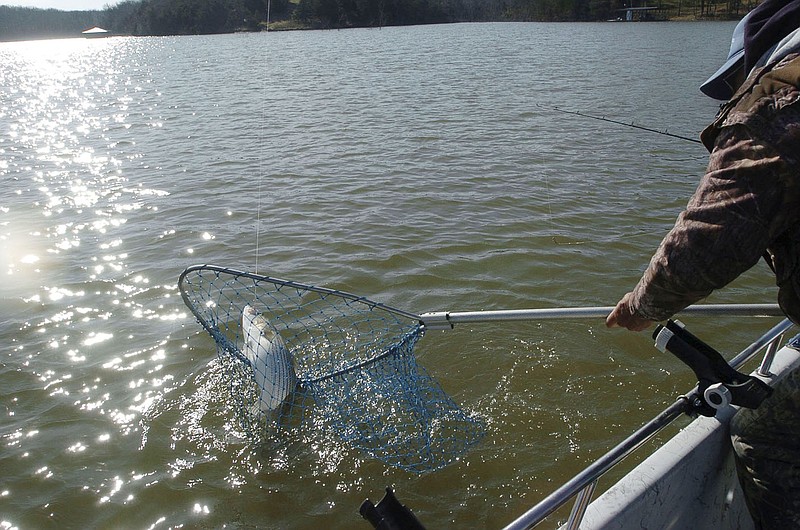Area anglers and fishermen from across the nation head to Beaver Lake to feel the strong pull from a big, hard-fighting striped bass.
Catching one is a downright giddy, heart-pounding fishing experience anglers have enjoyed almost since the lake filled in 1965. Striper fishing at Beaver Lake is some of the best in the nation. A study coming this summer by the Arkansas Game and Fish Commission aims to keep it that way.
Stripers go all the way back to 1968, four years after Beaver Lake was impounded. Back then, some fishermen circulated a petition to get nonnative striped bass stocked into the new lake, said Jon Stein, Northwest Arkansas fisheries supervisor for Game and Fish. About 100 people signed it.
Game and Fish soon started putting stripers into the reservoir. The fish grew big, up to 40 and 50 pounds. Striper fishing been great sport for decades and continues today.
"We've been contemplating doing more research on striped bass at Beaver for a long time," Stein said.
In December, he met with a group of striper fishing guides to gauge their cooperation in research that will take place in July and August.
First, participating guides will keep a detailed fishing diary for the two months every day they fish. They'll jot down when they started and when they stopped that day, how many clients were in their boat, how many fish per angler were caught and other details.
Game and Fish will place freezers at marinas around the lake. After cleaning fish for their customers, guides will place the heads of their catch in the freezers. Stein and fellow biologist Eric Gates will remove a small bone, called an otolith, from each head.
A new ring grows on the otolith each year similar to rings of a tree. The exact age of each fish can be determined by studying these otoliths, Stein said.
The July and August time frame was chosen because the guides said that's when they catch the most and biggest fish. It's hoped that at least 10 guides will participate in the research.
Goals are to get a better idea of the growth rate of stripers, to get better information on harvest and on c the health of the lake's striper fishery, Stein said. Data can be used to support adjusting regulations or stocking rates, if needed.
A number of stripers have been stocked at the lake most years starting in 1968. Since 2015, Game and Fish has stocked 200,000 fingerling stripers into Beaver Lake almost every year. Stripers are raised at the Game and Fish Andrew Hulsey State Fish Hatchery at Lake Ouachita. It's the only Game and Fish hatchery where stripers are raised, so there are only so many stripers to go around. Lakes Ouachita and Norfork also get stripers from the Hulsey hatchery.
Stripers are stocked because they can't spawn naturally in a reservoir environment. Eggs require current and there's not enough current in a lake to allow spawning success. Stein said the Arkansas River is the closet place to Beaver Lake where stripers spawn naturally.
He hopes the study at Beaver can be conducted each year "for as long as we can do it.". In 2022, the research will expand to include Lake Ouachita and Lake Norfork.
Fisheries biologist Eric Gates, Stein's co-worker at the district fisheries office in Rogers, will head the studies at Ouachita and Norfork.
It's all aimed at maintaining good fishing for stripers, a fish that some say is getting harder to catch at Beaver.
Tony Castro is president of the Beaver Lake Striper and Walleye Association. He keeps in regular contact with members even though the group hasn't met for a year because of the pandemic.
"Five or six years ago, we were catching 20-pound fish right and left. And 95% of it was catch and release. Now, stripers are tougher to find," Castro said. "It may be that it's a cycle. There are good years and bad years."
With Northwest Arkansas' population growing, more people are striper fishing, Castro said. There are more striper fishing guides on the lake than there were 10 or 20 years ago. Most legal fish on guide trips are harvested, Castro noted. Stripers must be 20 inches or longer to keep at Beaver. The daily limit is three.
He sees photos on social media of fishing parties keeping 12 or 15 stripers each day."The pressure is definitely there," Castro said.







More News
Catch a striped bass
Anglers use large minnows or live shad to catch stripers. Lures that imitate shad, such as crank bait and jigs, are good. A striper’s diet is 90% shad, said Jon Stein, Northwest Arkansas fisheries supervisor with Game and Fish.
Stripers must be 20 inches or longer to keep at Beaver Lake. The daily limit is three.
Source: Arkansas Game and Fish Commission

